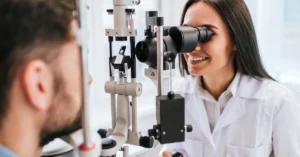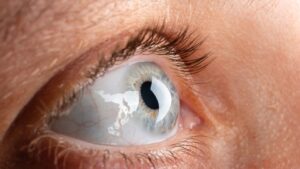What is Keratoconus?
Keratoconus is a progressive eye disorder that affects the shape and structure of the cornea, causing it to thin and become cone-shaped. This irregularity can lead to blurry vision, nearsightedness, astigmatism, and increased sensitivity to light. The exact cause of keratoconus remains unknown, but various studies suggest that genetics play a significant role in its development.
The Role of Genetics
Research has indicated a strong genetic component to keratoconus. Multiple studies have shown that individuals with a family history of keratoconus are at a higher risk of developing the condition compared to those without a known familial link. In fact, it is estimated that around 10% of keratoconus cases have a genetic basis.
Various genes have been implicated in the development of keratoconus, including those encoding enzymes responsible for collagen cross-linking, such as LOX (lysyl oxidase) and LOXL1 (lysyl oxidase-like 1). Collagen cross-linking is a natural process that strengthens the cornea; abnormalities in these genes can result in weaker corneal structure and increased susceptibility to keratoconus. However, it is essential to note that these genes are not the sole determinants of keratoconus and that environmental factors also play a role.
Familial Patterns
Studies have shown that keratoconus can exhibit various patterns of inheritance within families. Some cases follow an autosomal dominant pattern, which means that an affected individual has a 50% chance of passing the condition on to their offspring. In other cases, keratoconus may follow an autosomal recessive pattern, where both parents must carry the affected gene to have an affected child. Additionally, some families have shown evidence of multifactorial inheritance, which involves a combination of genetic and environmental factors contributing to the development of keratoconus.
Environmental Factors
While genetics are believed to be a significant contributing factor to the development of keratoconus, environmental factors also play a role. These environmental factors may further interact with genetic predispositions and contribute to the progression of the disease.
One prominent environmental factor associated with keratoconus is eye rubbing. Frequent and aggressive eye rubbing can put mechanical stress on the cornea, potentially weakening its structure and promoting the development of keratoconus. Allergies and chronic eye irritation may also contribute to the progression of the disease.
Other potential environmental factors include ultraviolet (UV) radiation exposure, hormonal imbalances, certain connective tissue disorders, and chronic eye inflammation. However, more research is needed to determine the extent of these factors influence on the development and progression of keratoconus.
Early Detection and Treatment
Keratoconus is typically diagnosed during puberty or early adulthood and tends to progress slowly over time. Early detection is crucial for effective management and treatment of the condition. Regular eye exams, particularly if there is a family history of keratoconus, can help identify any early signs or changes in corneal shape.
Treatment options for keratoconus depend on the severity of the condition. In mild cases, eyeglasses or soft contact lenses may improve vision. However, as the disease progresses, specialized contact lenses called RGP lenses or scleral lenses may be necessary to reshape the cornea and provide optimal visual acuity. In severe cases, corneal cross-linking, a procedure that strengthens the cornea, or even corneal transplant surgery may be required.
Conclusion
While the exact cause of keratoconus remains unknown, it is widely accepted that genetics play a significant role in its development. Research suggests that multiple genes, including those involved in collagen cross-linking, are associated with an increased risk of developing keratoconus. However, the disease is also influenced by environmental factors such as eye rubbing, UV radiation exposure, and chronic eye inflammation. Understanding the genetic and environmental factors contributing to keratoconus is crucial for early detection, effective management, and improved treatment options for individuals affected by this condition.







